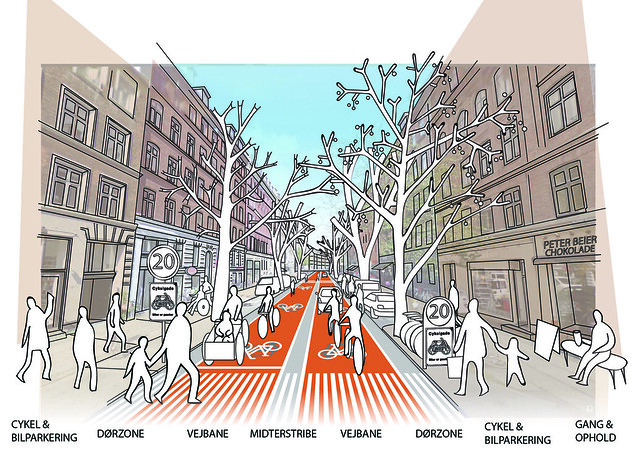
Sometimes you have to take matters into your own hands. Even in Copenhagen.
There is a street in a densely-populated neigbourhood in Copenhagen - Østerbro - without any cycle tracks. I know, I know... it's like a street in New York without honking taxis or a street in Paris without cafés populated by moody philosophy students. It's weird. Also because it's a long street in a thriving neighbourhood and it's one of the streets in the city with a far too high levels of incidents involving bicycles.
It's weird because it's a perfect street for cycle tracks. It's also weird because only 29% of households in Copenhagen even own a car but politicians and the City say that taking out car parking on this street would be "difficult".
A local politican, Jonas Bjørn Jensen, when campaigning for the last election decided to ask people in the neighbourhood if they wanted cycle tracks. Over 90% of the people he asked said, "yes".
Together with Ole Kassow from Purpose Makers and Thomas Lygum Sidelmann from Urban Action we at Copenhagenize Design Company decided to just do our own proposed street design. Enough talk. Let's get some imagery onto the table.
Above is the street as it looks now. Nordre Frihavnsgade (don't try to pronounce that please) is a central street in the Østerbro neighbourhood connecting Strandboulevarden, Trianglen and Østbanegade. It's an important shopping street and has a lively environment, with schools and shops and... life. There are 5800 bicycle users a day and 5300 cars. Ole Kassow, who lives nearby, has spoken with many locals and the general consensus is that the street doesn't feel safe. It's not nice to cycle on it. There are also many pedestrians crossing back and forth to the various shops and cafés and other destinations.
Bizarrely, the street is a 50 km/h zone, except at the narrowest section where it is "only" 40 km/h. One thing that Copenhagen sucks at is the fact that they haven't embraced the 30 km/h movement like the rest of Europe. If this street was in Amsterdam, Barcelona, Paris, Vienna, etc etc. it would be 30 km/h. Years ago.


Anyway, we decided to visualise what the street should look like. Our point of departure was that if cycle tracks are ooooh so difficult for the City of Copenhagen, then we will give them an easier, cheaper solution. The Dutch have their fietsstraat and while the Copenhagen Police have been vocal opponents of them - and most everything else that would improve cycling in the city - there is finally a pilot project on Vestergade in Copenhagen as we speak.
So we made the street a "cykelgade" - a bicycle street - dictating that cars are welcome as guests on the street but they have to drive at the tempo that the bicycle users dictate.
We designed a Danish version of the Dutch Fietsstraat signage, as well. Based on the Danish standards for pictograms and font.

Here is the street in it's full length. Our proposal would improve the street greatly. It would benefit local businesses, make pedestrians feel safer and it would be a new benchmark for neighbourhood planning in Copenhagen.

While there is nothing regarding bicycle infrastructure that we can learn from the Americans, the parklet concept is something that we can happily subscribe to. We included them in our designs to also plant this idea in the minds of Copenhageners. More of these would be fantastic.
It is vitally important to create visualisations. Talk is fine but when you design a visualisation, suddenly you have a whole group of different people who understand what you're on about. They are really powerful tools for change.
Cross your fingers for a positive development on this street.